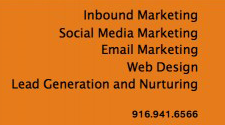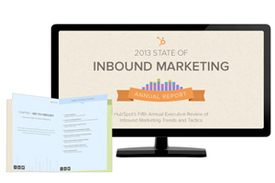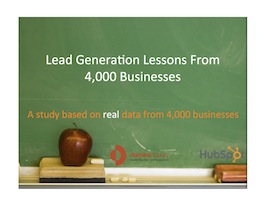I was introduced at a community event recently and was asked to say a few words about Domino Theory: Smarter Business Communications. The audience was a group of small- and mid-sized business owners. As a key part of our Inbound Marketing strategy, I prefer to learn about my customers business rather than focus on my own, so instead of talking about Domino Theory, I asked a series of questions. 1. How many of you have a formal marketing communications plan that you follow?
1. How many of you have a formal marketing communications plan that you follow?
About one third of the attendees in the room raised their hands.2. How many of you who raised your hands include Internet marketing in your communications plan?
About half of the first group raised their hands.3. How many of those include blogging and social media in their Internet communications plan?
Most of the group with hands raised kept them raised.4. How many of you with hands still raised apply analytics to your Internet communications to measure results?
Almost all the remaining hands dropped.5. How man of you would like to find more profitable customers?
All the hands in the room went up.This isn't unusual among small- and mid-sized businesses. Business owners are generally very good at what they do, they are also generally not very good at marketing, and by not being good at marketing they fail to reach optimum profitability. But here's the kicker, being good at your business is exactly what Inbound Marketing is all about!My father-in-law is retired in Arizona, but is a skilled woodworker and builds cabinets for friends and family to stay busy and make a little cash. The stuff he builds is really good (we have a number of pieces in our house here in El Dorado Hills). The woodworking he does requires special tools and special woods. So where do you think he shops? Does he go to Home Depot or does he go to specialty shops? He goes to specialty shops!The people who work in the specialty hops are experts! They know the tools and how to use them, they know the woods and their characteristics. They are able to talk his language, share tips, and act as a resource. The people at Home Depot can tell him in what aisle he might find what he needs.You're an expert in your business, right? Isn't that why customers come to you? You have the skills and knowledge to provide a product or service that is better than the competition. You deliver a memorable customer experience and build relationships with your customers so they continue doing business with you and refer their friends and business associates.An Inbound Marketing plan can do all of this and more!When you share your knowledge and expertise in blogs and social networks you establish your expertise, your role as the go-to business. It doesn't matter whether you run a restaurant, a dental practice, or any other business. Your customers want the same thing! They want access to your expertise. It's your job to share it with them!If you're a dentist, it's as easy as including a brief message in your appointment reminder e-mails about what procedures you will be performing at the appointment and why they are important. You can include a link to more information about them so your patient shows up informed and prepared. Everyone wants to like their dentist, but I like my aunt and don't want her fingers in my mouth. I want my dentist to demonstrate expertise!If you're a restaurant owner, the same thing applies. The most common social media posts I see from restaurants are about specials, what's for lunch, and what a great place your spot is to watch the game. People may want to know that information, but most aren't on social networks to be sold something! You need to offer more! Want customers to watch the game at your place? Tell them about that crazy AV system you had installed! Write a blog post and get into the nitty gritty, how many screens, how many games can be watched at once, how the system is networks, why it's the best! Want them eating in your restaurant? Share how you source food, your special preparation techniques, the special equipment i your kitchen that allows your chef to outperform the home cook.But all of this takes a plan! It requires goal setting, timelines, publishing schedules, monitoring, and measurement. As a lawyer, you would never argue a case by the seat of your pants - don't market your practice by the seat of your pants either!
If you enjoyed this article and found it useful, please share it with your social networks or e-mail it to friends and colleagues using the buttons below.
Tags:
Content Marketing,
Inbound marketing,
social media,
Facebook,
Communications,
plan,
Business,
El Dorado Hills,
blog,
Social,
Honest,
Sacramento,
Folsom,
Smarter
"Don't tell me who I might reach, tell me exactly who I have reached, so I can follow them up and sell them something... even if that means losing a ton of 'untrackable' sales."
 This is the conundrum facing traditional media in a social media world - the world I lived in for 25+ years before launching Domino Theory. Advertising in traditional media is all about Reach, Frequency, and Cost per Thousand. It's about intruding on an audience that is previously engaged in the hopes that your message is sufficiently interesting that it will be viewed as a value-add.While research can be done to show that your message is being delivered to the proper audience, the problem is that it assumes I am interested in your product or service right now! So what's the answer? How should marketers use traditional media?In a Smarter Business Communications plan, advertising should do two things: Drive awareness and drive action.
This is the conundrum facing traditional media in a social media world - the world I lived in for 25+ years before launching Domino Theory. Advertising in traditional media is all about Reach, Frequency, and Cost per Thousand. It's about intruding on an audience that is previously engaged in the hopes that your message is sufficiently interesting that it will be viewed as a value-add.While research can be done to show that your message is being delivered to the proper audience, the problem is that it assumes I am interested in your product or service right now! So what's the answer? How should marketers use traditional media?In a Smarter Business Communications plan, advertising should do two things: Drive awareness and drive action. Driving Awareness
Driving Awareness
If you include pre- and post-awareness research as part of your marketing program, traditional media can be a great tool. After all, people need to be aware of your product before they can educate themselves about it. However, it you're not asking customers and prospects the right questions, how can you justify your traditional ad buy?Driving Action
Sales are the ultimate action step (well, unless you count re-purchases and referrals). But before your customer gets to the purchase, they go through a number of other steps, and none more important than Education.So what would it look like if you assume the Awareness piece and focus on Education as your Action? What would you want your traditional ad to accomplish?First, you need a measurable objective (if you can't count it, why do it?). Let's just say you want your prospect to learn more about your product or service. How could you accomplish this? It's really pretty easy, offer the information they will need before they are able to make a buying decision! BUT, don't put that information in your ad! Offer the information, for free, on your web site. (Your web site isn't a 21st century Yellow Pages ad, is it?). This is the first step toward turning your untrackable sales into trackable leads. The white paper, product info, video, pictures, slidshow, webinar, or whatever tool you're using to educate your audience is free, but in exchange you ask for an e-mail address. You now have a prospect with whom you can communicate (if they won't give you an e-mail address, either your offer is not meeting their needs, or they weren't a good prospect to begin with!).You now are starting to collect actionable data from your traditional advertising. Of the people you reached, how many took action? (If the numbers aren't what you needed, you need to review your message, your offer, and your media buy). How many asked for more information?Traditional advertising still serves an important role in your advertising and marketing programs, but only if you use it to drive traffic to your inbound marketing funnel!
If you enjoyed this post and found it informative and useful, please use the buttons below to share it via e-mail and on your social networks.
Tags:
leads,
Marketing,
Content Marketing,
Inbound marketing,
social media,
Communications,
Customer Acquistion,
plan,
Business,
El Dorado Hills,
Sacramento,
Folsom,
El Dorado County
Do you have a sales process? Unless you're just winging it, you likely track your sales prospects through a series of steps until they purchase - or not. Perhaps you call it a sales funnel, lead nurturing, or have another name for it. When you built this process, did you consider that your customers also have a buying process? Does your sales process mirror the buying process?A buying process? At Domino Theory: Smarter Business Communications we coach our clients to mirror the buying the process rather than force your buyers through your sales process. Let's take a look.Forget about your customers for a minute and think about yourself - we're all making buying decisions all the time. What is the process your buying journey takes?Whether we're buying a new pair of shoes, a new car, or a new backpacking tent, we generally will travel the same path. If you keep this path in mind during your sales process, you'll be able to lead your customers through the process, helping them with the right information at the right time leading to the decision that fits their needs - a purchase of your goods or services!It could very well be a new watch, pair of shoes, bottle of wine, or a skateboard for your son, the process is typically similar. To simplify this, let's look at the 6 Steps in a typical car purchase.Interest
Your lease is up, your car is spending too much time in the shop, or you just want a shiny new car with all the latest technology. Whatever your reason, you have developed an interest in buying a new car (new car, used car, it doesn't really matter, the process is the same). This stage can be short (your lease is up, your engine seized, etc), or longer (you want to replace your vehicle, but have no urgency). Whatever the reason, you have developed an interest in purchasing a vehicle.Educate
The next step on our buying path is to educate ourselves. With so much information available online, the Internet is the go-to place where most of us begin to research. Some people check the car sites, some read safety information, others want to know about performance, reliability, or fuel efficiency. We look at pictures, color options, interiors finishes.We also seed advice from friends, family, and even strangers. We ask questions of people who own a similar make and model. perhaps we visit bulletin boards online or post questions to our Facebook friends. How many people does it seat? How comfortable is it? How much does it cost? What are the advantages of buying new versus used?Ultimately we visit the dealer or a private seller. Here we continue to educate ourselves. We inspect the car, get brochures, ask more questions, and more likely than not get hit with a sales pitch that makes uncomfortable (because we're still educating ourselves, we're not ready to make a decision yet!!)Have you noticed how long and and extensive the education process can be? This is why Domino Theory is such a strong believer in Content Marketing! Ultimately, though, we are ready to move to the next step.Transfer
Finally, we're ready to get behind the wheel for a test drive. Ownership has been transferred, at least temporarily. This is the same thing as when we try on a new pair of shoes or listen to music sample on iTunes. When you try the free samples at Costco, the seller knows you are one step closer to making a purchase decision.While that 5-minute test drive around the block gives us information about the car, it also allows us to take ownership of the vehicle and see how it feels to own it. Some people want to crank the stereo, others step on the gas and give it a go, while others just want to get a feel for how they look in the car - do people check it out?Justify
We've reached the 5th step of our purchasing journey. Can we justify the purchase? Do I really need a new car? Can I really afford it? Should I be buying used? Should I be buying a new car? Do I really want an SUV with gas prices where they are? Can I fit all my stuff in this little hybrid? Do I really need all the performance? Is red too flashy? Will silver look clean longer? Can I buy a used car from someone I've never met before?A lot of times our purchasing process ends here. If we can't justify the purchase, it's time to go back and Educate ourselves further and cycle through the process again. Think about how man pair of shoes you've put back in the box and handed back to the sales person, how many boxes of cereal you've put back on the shelf, how many restaurants your didn't walk into after reading the menu outside. You couldn't justify the purchase even though there was a product that potentially satisfied your needs.If you are able to Justify, you finally move to the final stage.Decide
You're ready to buy. No one "closed" you with a hard sell - or if they did, you were still able to justify your purchase. You drive home in your new car, and you immediately become part of someone else's Education process as they check out your new car and ask you questions about it and where you got it.This sounds familiar, doesn't it? Now apply this process to your customers and their purchasing process. What can you do to Interest them, Educate them, to get them to sample your offering, to demonstrate the ROI, and ultimately to Decide that your product and service is just what they were looking for?When you align your sales process with your customers' buying process, you are able to hold thier hand and pull them to the next step. If you know they're interested, help educate them. If you know they are educated, give them a way to sample try out what you're offering. Once they've tried it, validate why your service meets the criteria they've shared with you.Then, close the deal!
If you have enjoyed this post and found it useful, please use the buttons below to share it with your social networks and forward to friends.
Tags:
leads,
Marketing,
Content Marketing,
Inbound marketing,
Facebook,
Communications,
Customer Acquistion,
Business,
El Dorado Hills,
word-of-mouth,
strategic,
customers,
Sacramento,
Folsom,
Smarter,
El Dorado County








